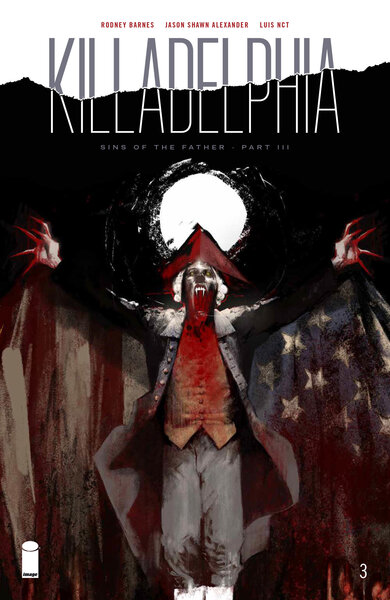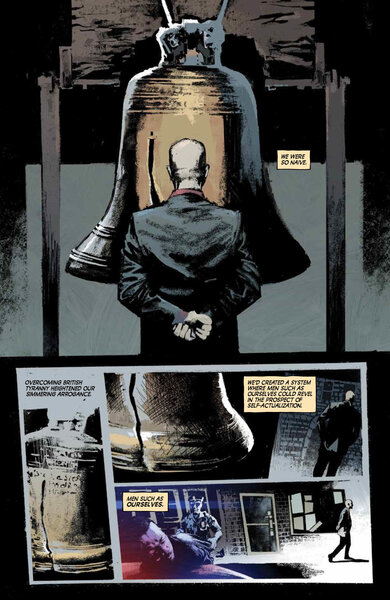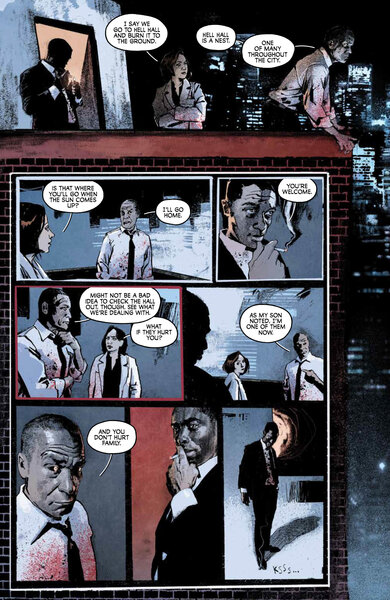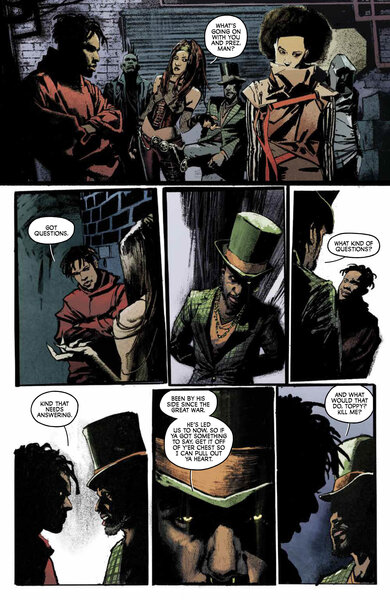Create a free profile to get unlimited access to exclusive videos, sweepstakes, and more!
Indie Comics Spotlight: Killadelphia is Rodney Barnes' ode to Dracula and The Wire
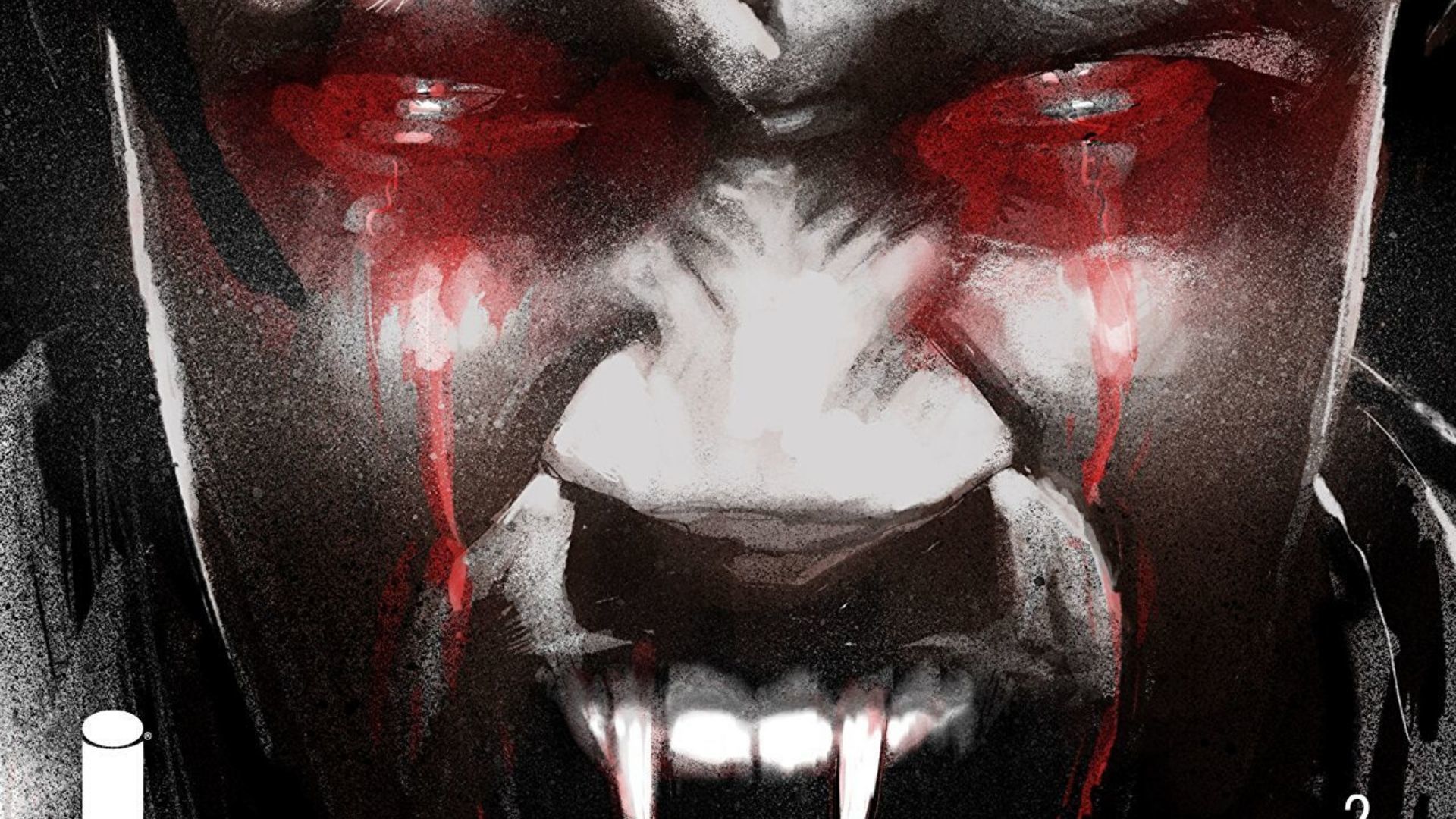
There is a high probability that if you are a fan of comics, science fiction, or horror, you've read or seen something that Rodney Barnes has worked on. The award-winning writer and producer is best known for his work on The Boondocks, American Gods, and Marvel's Runaways. But his first love is comic books.
He's penned a jaded post-Secret Wars Sam Wilson in The Falcon (Marvel), showed us a teen struggling through high school with a new superpower in Quincredible (Lion Forge), and even turned Lando from loverboy into freedom fighter in Star Wars: Lando: Double or Nothing (Marvel). Barnes has a talent for placing everyday relatable characters into extraordinary supernatural situations, while often weaving relevant social commentary throughout.
Barnes' newest comic Killadelphia (Image), echoes these qualities. Jim Sangster, Jr. travels from Baltimore to Philadelphia to bury his father James Sr., a detective who was close to retirement when he died investigating a series of murders tied to a mysterious teen — a boy no one can catch and who's only been seen at night. It turns out the teen is not exactly alive and Jim Sr. is no longer exactly dead. Both turned into undead vampires in the coven of, wait for it... John Adams.
Yes, Rodney Barnes has written a vampire story where the primus is the Second President of the United States. His coven now resides in West Philly. What pulls you in is Jason Shawn Alexander's stunning noir artwork blended with Luis NCT's minimalist and muted color palette. It's Dracula meets The Wire in a paranormal crime story laced with politics, legacy, and, yes, vampires. Lots of vampires.
SYFY WIRE caught up with Rodney Barnes to find out why he loves cop stories and horror movies, and how his father served as inspiration for James.
Were you a horror fan as a kid?
I've been a fan of horror for as long as I can remember. I had models of all the Universal monsters as a kid and watched creature features every weekend on TV. Literally it's the first genre I can recall loving. I consumed mass amounts of horror as a kid. Phantasm, Romero's Living Dead series, Wes Craven, John Carpenter… literally everything!
What were your favorite vampire movies, books or comics?
The Christopher Lee/Peter Cushing vampire films. As well as the Lon Chaney Wolf Man films were first. Kolchak: The Nightstalker, Salem's Lot, Bram Stoker's Dracula, whether in book form or television, was an instant draw. Anne Rice's The Vampire Chronicles, Near Dark… the list goes on...
What was your source for comics growing up?
I bought most of my comics from the Royal Farm Store in my hometown of Annapolis, Maryland. My addiction was so severe that I'd beg, borrow, or steal if I saw a Neal Adams Batman or Green Lantern cover.
Later, my friend Frank Brown, who had a car, would drive to Baltimore to the only comic shop in the area, Geppi's Comic World, in the inner harbor. Those were the days.
How did you get involved with this project?
Killadelphia has been growing in my psyche since I was eight or nine years old. The Kolchak: The Night Stalker movie of the week started it all. Darren McGavin chasing a vampire (written by the late great Richard Matheson) sparked a flame that's never stopped burning.
There has been a myriad of other influences since, but that was the first. Fast-forward 40 years when I met Jason Shawn Alexander and pitched him the idea. The expression on his face was priceless. We pitched it to Image Comics and the rest is history.
What do you love about comic book scripts over episodic TV writing?
The sparseness of comic book scripts is a plus, as well as the freedom. In the beginning [at Marvel Comics when I wrote The Falcon], it was overwhelming. I had no idea what the boundaries were, whereas in TV, the boundaries are popping up everywhere.
Since writing the comics Lando: Double or Nothing and Quincredible, I've gotten more comfortable with the relationship between words and art, but it's still a learning process.
As far as preference, it's more about the nature of the type of story I'm telling rather than if it's a television or comic script.
You've somehow managed to tie a cop, a vampire teenager and former President into one story. Was that the goal from the moment you began working on this?
[Laughs] Yes, my goal was to get three distinctly different voices to carry the narrative. Three entry points into the world. So it was certainly intentional. I wanted the life/death story of those driving the narrative to come from wildly different points of view. The only connector is that they're all dead. Well, undead.
Tying the "Sons of the Republic" riots to the vampires was brilliant. What made you decide to use that particular reference? How much research did you do for this comic?
Thank you. I did a ton of research. I'm going deep into the rabbit hole of American history and I want it to feel plausible. Those that ask, "Why John Adams?" will get their answer and hopefully they don't feel cheated. I didn't randomly pick him, and those that stay the Killadelphia course will get it.
For as long as I can remember, folks have questioned how history affects African-American culture. My goal was to answer one aspect of that question. The "Sons of the Republic" is directly related to the ideology of those pockets of uber-passionate folks who don't just rally or vote, they go to extremes politically and form militias. How would a group that had that type of passion actualize itself if it weren't bound by time?
It's no longer about Democrat or Republican, it's about its own ideology forged over centuries.
Were José or Jim inspired by real-life characters?
James Sangster, Jr. and James Sangster, Sr. is sort of me putting the relationship I've had with my father, myself, and my son under a microscope and trying to figure it out.
José as well is patterned after several folks. I tend to look at patterns of thoughts in folks that intrigue me or scenarios I've wrestled with or am currently wrestling with as fodder to build stories from. It forces me to write from the heart rather than just the mind.
Placing all of this horror against the backdrop of a homicide division in Philadelphia seems like a bold choice. Why place this story there?
I love cop mysteries. As a kid, the one-hour network drama was a staple of my television watching diet. Homicide: Life on the Street, was my favorite television show and probably the most influential to my television drama writing style (Thanks, Tom Fontana!), so using the backdrop of a homicide division and detective helped refine a natural structure as well as a sense of familiarity.
Who doesn't know what a homicide detective does?
Plus, it's fun. Philadelphia is associated with an aspect of American history and it also wrestles with a number of social ills. For a story with a political slant as well as a social component, it's perfect. And very few comics, TV shows, or films place their stories there. So, Philadelphia it is.
The use of handwritten notes mixed with standard speech bubbles worked beautifully, whose idea was that?
Jason Shawn Alexander was the beautiful mind behind the handwritten notes. It gave Jimmy's reading of the journal a believability that's necessary to the goal of our story. Can't say enough about how honored I am to be traveling this journey with him as well as our entire team.
The artwork is stunning. What was it like working with Jason and Luis NCT?
Again, Jason, Luis NCT, Marshall Dillon, Brent Ashe, as well as our editing team Greg Tumerello and Shannon Bailey, are all top-notch.
At Marvel and Lion Forge, all I had to do was write a script and a comic book would magically pop up. In indie comics, it's like a business, and without those folks, I'm certain it wouldn't have come out as it did.
This is a very layered story. Are the city and its corruption the other character in this story?
Shows like The Wire beautifully depict what corruption looks like in a major city. I wanted to speak to an aspect of that because cities don't just become "bad." The pathology is in the system, not the people. They're just reacting to the desperation of a lack of resources. I wanted to speak to this in a small way, not just show violence.
This comic is very cinematic, any plans to develop it into a movie or a show on streaming?
All I can say is there are great things happening in regards to developing Killadelphia for television. Hopefully, an official announcement can be made soon.
